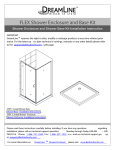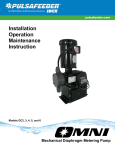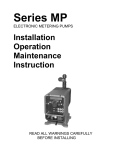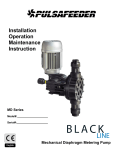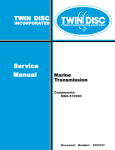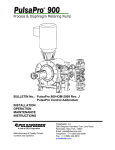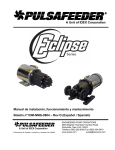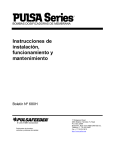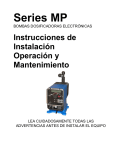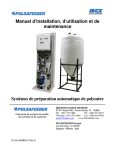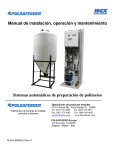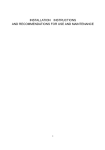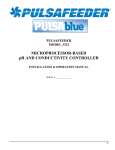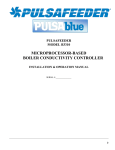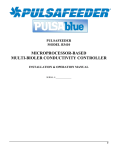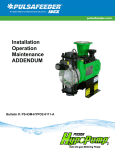Download LCM_IOM revD - Depco Pump Company
Transcript
Installation, Operation, & Maintenance Instruction Bulletin #: IOM-PN-LCM-0403- D Manufacturers of Quality Pumps, Controls and Systems ENGINEERED PUMP OPERATIONS 2883 Brighton Henrietta Townline Road Rochester, New York, 14623 Telephone (585) 292-8000 Fax (585) 424-5619 www,pulsa.com Pulsafeeder Factory Service Policy Should you experience a problem with your Pulsafeeder pump, first consult the troubleshooting guide in your operation and maintenance manual. If the problem is not covered or cannot be solved, please contact your local Pulsafeeder Sales Representative, or our Technical Services Department for further assistance. Trained technicians are available to diagnose your problem and arrange a solution. Solutions may include purchase of replacement parts or returning the unit to the factory for inspection and repair. All returns require a Return Authorization number to be issued by Pulsafeeder. Parts purchased to correct a warranty issue may be credited after an examination of original parts by Pulsafeeder. Warranty parts returned as defective which test good will be sent back freight collect. No credit will be issued on any replacement electronic parts. Any modifications or out-of-warranty repairs will be subject to bench fees and costs associated with replacement parts. Safety Considerations: 1. Read and understand all related instructions and documentation before attempting to install or maintain this equipment 2. Observe all special instructions, notes, and cautions. 3. Act with care and exercise good common sense and judgment during all installation, adjustment, and maintenance procedures. 4. Ensure that all safety and work procedures and standards that are applicable to your company and facility are followed during the installation, maintenance, and operation of this equipment. Copyright ©2004 Pulsafeeder, Inc. All rights reserved. Information in this document is subject to change without notice. No part of this publication may be reproduced, stored in a retrieval system or transmitted in any form or any means electronic or mechanical, including photocopying and recording for any purpose other than the purchaser’s personal use without the written permission of Pulsafeeder, Inc. ii Table of Contents 1. INTRODUCTION ...........................................................................................................................1 2. PRINCIPLES O F OPERATION .........................................................................................................1 2.1 Overall Operation ...........................................................................................................1 2.2 Reagent Head Assembly ................................................................................................1 2.3 Control Assembly...........................................................................................................1 2.4 Gear Ratio Assembly......................................................................................................1 3. EQUIPMENT INSPECTION ..............................................................................................................2 4. STORAGE ................................................................................................................................2 5. 6. 7. 4.1.1 Short Term...............................................................................................................2 4.1.2 Long Term ...............................................................................................................2 INSTALLATION ............................................................................................................................2 5.1 Location .........................................................................................................................2 5.2 Piping System ................................................................................................................3 5.3 Suction Pressure Requirements.....................................................................................3 5.4 Discharge Pressure Requirements.................................................................................3 EQUIPMENT STARTUP ..................................................................................................................4 6.1 Fastener Inspection........................................................................................................4 6.2 Output Adjustment .........................................................................................................4 6.3 Priming the Reagent Head..............................................................................................5 6.4 Calibration......................................................................................................................6 MAINTENANCE ...........................................................................................................................7 7.1 Lubrication .....................................................................................................................7 7.2 Wet End Removal , Inspection, & Reinstallation ............................................................8 7.2.1 7.3 8. 9. Diaphragm Removal & Reinstallation......................................................................9 Check Valves..................................................................................................................10 7.3.1 General Description.................................................................................................10 7.3.2 Check Valve Removal & Reinstallation....................................................................11 7.4 Motor Removal & Reinstallation.....................................................................................11 7.5 Gearset Removal............................................................................................................12 7.6 Gearset Replacement.....................................................................................................13 R EPLACEMENT PARTS.................................................................................................................14 8.1 KOPkit Program .............................................................................................................14 8.2 Ordering KOPkits or Parts..............................................................................................14 TROUBLESHOOTING ....................................................................................................................15 10. PIPING ACCESSORIES .................................................................................................................17 11. DIMENSIONAL D RAWINGS ............................................................................................................18 12. PARTS DIAGRAMS AND PARTS LISTS .............................................................................................20 13. MAINTENANCE LOG ....................................................................................................................25 iii iv 1. Introduction PULSAtron Series M metering pumps are positive displacement reciprocating pumps. Each pump consists of a power end and a process end separated by a mechanically operated diaphragm. Individual pumps will vary in appearance due to various liquid ends and accessories, however, the basic principles of operation remain the same. 2. Principles Of Operation 2.1 Overall Operation Figure 1 A diaphragm reciprocates at a preset stroke length, displacing an exact volume of process fluid. Diaphragm retraction causes the product to enter through the suction check valve. Diaphragm advance causes the discharge of an equal amount of the product through the discharge check valve. 2.2 Reagent Head Assembly The typical reagent head assembly consists of reagent head, diaphragm, and suction and discharge cartridge check valves. This assembly is the only part of the pump to contact the process liquid; consequently, maintenance is critical to pump performance. 2.3 Control Assembly PULSAtron Series M pumps incorporate a lost motion style of stroke length adjustment to limit diaphragm travel during the suction portion of each stroke. The stroke length setting is indicated by a (0% – 100%) scale located on the stroke adjustment assembly. Stroke length is changed by loosening the locking screw and turning the hand knob. This turns a mechanism which limits rearward travel of the diaphragm. 2.4 Gear Ratio Assembly PULSAtron Series M pumps are driven by an electric motor mounted on the motor adaptor input flange. The motor drives a set of worm gears that convert rotational speed into torque. They, in turn, power the eccentric shaft assembly that converts rotary motion into reciprocating motion. 1 3. Equipment Inspection Check all equipment for completeness against the order and for any evidence of shipping damage. Shortages or damage must be reported immediately to the carrier and your authorized representative or distributor of PULSAtron Series M pumps. 4. Storage 4.1.1 Short Term Storage of PULSAtron Series M pumps for up to 12 months is considered short-term. The recommended short-term storage procedures are: a) Store the pump indoors at room temperature in a dry environment. b) If required by the operating environment, take precautions to prevent entry of water or humid air into the eccentric enclosure. c) Prior to startup, perform a complete inspection and then start up in accordance with instructions in this manual. 4.1.2 Long Term Every twelve months, in addition to the above short-term procedures, power up the motor and operate the pump for a minimum of one hour. It is not necessary to have liquid in the reagent head during this operation, but the suction and discharge ports must be open to atmosphere. After twelve months of storage, Pulsafeeder’s warranty cannot cover such items which are subject to deterioration with age such as seals, gaskets, and diaphragms. If the pump has been in storage longer than 12 months it is recommended that such items be inspected and replaced as necessary prior to startup. Materials and labor to replace this class of item under this circumstance are the purchaser’s responsibility. For a continuance of the initial warranty after extended storage, equipment inspection and any required refurbishing must be done by a Pulsafeeder representative. 5. Installation 5.1 Location When selecting an installation site or designing a chemical feed package system, consideration should be given to access for routine maintenance. PULSAtron Series M pumps are designed to operate indoors and outdoors, but it is desirable to provide a hood or covering for outdoor service. External heating is required if ambient temperatures below 0° C (32° F) are anticipated. Check with the factory if concerned with the suitability of the operating environment. The pump must be rigidly bolted to a solid and flat foundation to minimize vibration, which can loosen connections. When the pump is bolted down, care must be taken to avoid distorting the base and affecting alignments. The pump must be level within 5°. This will assure that the check valves can operate properly. 2 5.2 Piping System All piping systems should include: 1. A separate system relief valve to protect piping and process equipment, including the pump, from excess process pressures. An external relief valve is required! 2. Shutoff valves and unions (or flanges) on suction and discharge piping. This permits check valve inspection without draining long runs of piping. Shutoff valves should be of the same size as connecting pipe. Ball valves are preferred since they offer minimum flow restriction. 3. An inlet strainer, if appropriate for the product being pumped. Pump check valves are susceptible to dirt and other solid contaminants, and any accumulation can cause malfunction. The strainer should be located between the suction shutoff valve and the pump suction valve. It must be sized to accommodate the flow rate and the anticipated level of contamination. A 100 mesh screen size is generally recommended. 4. Vacuum/pressure gauges in the suction and discharge lines in order to check system operation. Gauges should be fitted with protective shutoff valves for isolation while not in use. Piping weight must not be supported by valve housings or other portions of the reagent head, as the resulting stresses can cause leaks. If appropriate, provide for thermal expansion and contraction so that no excess force or moments are applied to the pump. When making process connections, ensure that the check valve assemblies do not rotate as the threaded connections are secured. It is critical, especially with plastic construction, that the check valves not be too tight into the reagent head. In piping assembly, use a sealing compound chemically compatible with the process material. Users of sealing tape are cautioned to ensure that the entering pipe thread ends are not taped, and that tape is removed from previously-used threads to the maximum practical extent prior to re-use. Both new and existing piping should be cleaned, preferably by flushing with a clean liquid (compatible with process material) and blown out with air, prior to connection to the pump. 5.3 Suction Pressure Requirements Although PULSAtron Series M metering pumps have some suction lift capability, a flooded suction (i.e., suction pressure higher than atmospheric pressure) is preferable whenever possible. The pump should be located as close as possible to the suction side reservoir or fluid supply source. For fluid with a vapor pressure of 5 psia or less (at operating temperature) the wet suction lift capability is approximately ten (10) feet. If this requirement is not met, the pump will not provide reliable, accurate flow. In suction lift conditions, the use of a foot valve is recommended at the lowest point of the pickup tube or pipe. Pumps under suction lift conditions may require some liquid priming before they will operate reliably. 5.4 Discharge Pressure Requirements All PULSAtron Series M Metering Pumps are designed for continuous service at the rated discharge pressure. If system suction pressure exceeds discharge pressure (a condition sometimes described as “pumping downhill”), flow would be generated (siphoning) in addition to that caused by the pump. This results in a reduction in accuracy and loss of control over the metering process. To prevent this condition, commonly referred to as “flow through”, the discharge pressure must exceed suction pressure by at least 0.35 Bar (or 5 psi). This can be achieved where necessary by the installation of a backpressure valve in the discharge line. 3 6. Equipment Startup 6.1 Fastener Inspection All pump fasteners should be checked prior to pump operation. This would include reagent head mounting bolts, motor mounting bolts, and the hardware that secures the pump to its foundation. Most hardware can be checked simply to ensure it is not loose. However, utilize the following values when checking reagent head bolt torque: Head Bolts Model LI2 Plastic Metal # Bolts and size (4) M6 * 1.0 (4) M6 * 1.0 Torque N-m In. - Lbs 3.39 30 3.39 30 # Bolts and size (4) M8 * 1.25 (4) M8 * 1.25 Torque N-m In. - Lbs 6.77 60 6.77 60 Model LI4 Plastic Metal 6.2 Output Adjustment All PULSAtron Series M pumps have a hand wheel for manual stroke adjustment. The hand wheel can be adjusted at any point from 0 to 100% stroke setting . 1. Turn the lock screw counterclockwise to release the stroke lock. 2. Adjust the hand wheel to the desired output. a) The stroke barrel indicates stroke length in 20% increments. b) The hand wheel indicates stroke length in 1% increments. To set the pump to 75% stroke length, (starting from the factory default setting of 0%) turn the hand wheel counter clockwise until he 60% indicator is visible on the stroke barrel. Continue the counter clockwise rotation until the hand wheel indicator is at 15. Refer to the drawing on the right side of the page. 3. Turn the lock screw clockwise to lock the stroke adjustment into position. Figure 2 Adjustments can be made while the pump is at rest or operating, although adjustments are easier to make while the pump is in operation. 4 6.3 Priming the Reagent Head 1. When handling process liquids, follow all applicable personal and facility safety guidelines. 2. Ensure that the pump is ready for operation and that all process connections are secure. 3. Open the suction and discharge line shutoff valves. 4. If the piping system design and the storage tank are such that the product flows due to gravity through the pump, reduce the discharge pressure and the system will self prime when the pump is started. In the event the discharge line contains a significant amount of pressurized air or other gas, it may be necessary to lower the discharge pressure to enable the pump to self-prime. 5. If the installation involves a suction lift, it may be necessary to prime the reagent head and suction line. Operate the pump as in step 4 above, many times the pump will be capable of self priming. If it does not begin to pump, remove the discharge valve assembly. Carefully fill the reagent head through the discharge valve port with process (or compatible) liquid, and then reinstall the check valve. 6. Start the pump at the zero stroke length setting and slowly increase the setting to 100 to prime the pump. If this does not work, it will be necessary to fill the suction line. 7. Filling of the suction line will necessitate the use of a foot valve or similar device at the end of the suction line so that liquid can be maintained above the reservoir level. Remove the suction valve assembly, fill the line, replace the suction valve, then remove the discharge valve assembly and fill the reagent head as described in Step (3) above. The pump will now self-prime when started up per step (4) above. 5 6.4 Calibration Figure 3 All metering pumps must be calibrated to accurately specify stroke length settings for required flow rates. A typical calibration chart is shown above. Although output is linear with respect to stroke length setting, an increase in discharge pressure decreases output uniformly, describing a series of parallel lines, one for each pressure (only two are shown). The theoretical output flow rate at atmospheric discharge pressure is based on the displacement of the diaphragm, stroke length and the stroking rate of the pump. With increasing discharge pressure there is a corresponding decrease in output flow. Pumps are rated for a certain flow at a rated pressure (check nameplate). Whenever possible, calibration should be performed under actual process conditions (i.e., the same or a similar process liquid at system operating pressure). To construct a calibration chart, measure the flow rate several times at three or more stroke settings (i.e., 25, 50, 75, and 100), plot these values on linear graph paper, and draw a best-fit line through the points. For stable conditions, this line should predict settings to attain required outputs. 6 7. Maintenance BEFORE PERFORMING ANY MAINTENANCE REQUIRING REAGENT HEAD OR VALVE (WET END) DISASSEMBLY, BE SURE TO RELIEVE PRESSURE FROM THE PIPING SYSTEM AND, WHERE HAZARDOUS PROCESS MATERIALS ARE INVOLVED, RENDER THE PUMP SAFE TO PERSONNEL AND THE ENVIRONMENT BY CLEANING AND CHEMICALLY NEUTRALIZING AS APPROPRIATE. WEAR PROTECTIVE CLOTHING AND EQUIPMENT AS AP PROPRIATE. Accurate records from the early stages of pump operation will indicate the type and levels of required maintenance. A preventative maintenance program based on such records will minimize operational problems. It is not possible to forecast the lives of wetted parts such as diaphragms and check valves. Since corrosion rates and operational conditions affect functional material life, each metering pump must be considered according to its particular servic e conditions. PULSAtron Series M KOPkits contain all replacement parts normally used in a preventative maintenance program. It is recommended that KOPkits and PULSAlube grease be kept available at all times. 7.1 Lubrication PULSAtron Series M pumps are supplied completely lubricated from the factory. For optimum pump performance gear grease should be redistributed every 500 hours. 1. Disconnect the power source to the drive motor, and relieve all pressure from the piping system. 2. Remove the side cover from the pump. Refer to Figure 4. 3. Redistribute grease onto gear and worm teeth. On LI2 pumps, force grease into the hole in the end of the gear shaft using a screwdriver or putty knife. 4. Replace the side gasket and cover. Figure 4 7 7.2 Wet End Removal , Inspection, & Reinstallation IF THE DIAPHRAGM HAS FAILED, PROCESS FLUID MAY HAVE CONTAMINATED THE PUMP ECCENTRIC HOUSING (ALTHOUGH NORMALLY, ANY PROCESS FLUID BEHIND A FAILED DIAPHRAGM WOULD PASS THROUGH THE BOTTOM DRAIN HOLE). H ANDLE WITH APPROPRIATE CARE. Figure 5 PULSAtron Series M diaphragms do not have a specific cycle life; however, the accumulation of foreign material or debris sufficient to deform the diaphragm can eventually cause failure. Failure can also occur as a result of system over pressure or chemical attack. Periodic diaphragm inspection and replacement are recommended. 8 7.2.1 Diaphragm Removal & Reinstallation 1. Adjust the stroke setting to 50% and disconnect the power source to the drive motor. 2. Relieve all pressure from the piping system. O Take all precautions described under the WARNING on the previous page to prevent environmental damage and exposure of personnel to hazardous materials. 3. Close the inlet and outlet shutoff valves. 4. Place a pan underneath the pump head adaptor to catch any liquid leakage. 5. Disconnect piping to the reagent head and drain any process liquid, following material safety precautions described. 6. Remove all but one top reagent head bolt. Product will leak out between the pump head adaptor and reagent head as the bolts are loosened. 7. Tilt the head and pour out any liquids retained by the check valves into a suitable container, continuing to follow safety precautions as appropriate. 8. Remove the final bolt and rinse or clean the reagent head with an appropriate material. 9. Remove the dia phragm by turning it counter-clockwise. 10. Inspect the diaphragm. The diaphragm must be replaced if it is cracked, separated, or obviously damaged. 11. Install the diaphragm. a) Ensure that the critical sealing areas of diaphragm, reagent head, and pump head are clean and free of debris. b) Lubricate the elastomer side of the diaphragm liberally, where it is in contact against the pump head and deflection plate with a lubricant compatible to the fluid being pumped (silicone grease is preferred). 12. Thread the diaphragm (clockwise) fully onto the shaft. When reinstalling a used diaphragm it is not necessary to maintain the previous orientation relative to the reagent head or pump head hole pattern. 13. Install the reagent head bolts and tighten in an alternating pattern to ensure an even seating force. Torque to the values recommended in Section 6.1. 14. Re-prime the pump following the procedure outlined in Section 6.3. 9 7.3 7.3.1 Check Valves General Description Most fluid metering problems are related to check valves. Problems usually stem from solids accumulation between valve and seat, corrosion of seating surfaces, erosion, or physical damage due to wear or the presence of foreign objects. The valve incorporates a ball, guide, and seat. Flow in the unchecked direction lifts the ball off the seat, allowing liquid to pass through the guide. Reverse flow forces the ball down, sealing it against the sharp edge of the seat. The guide permits the ball to rotate but restricts vertical and lateral movement in order to minimize “slip” or reverse flow. Ball rotation prolongs life by distributing wear over the entire surface of the ball. Since ball return is by gravity, the valve must be in the vertical position in order to function properly. Parts are sealed by “O”-rings. Figure 6 10 7.3.2 Check Valve Removal & Reinstallation Valving is of the cartridge design and is intended to be replaced as an assembly. 1. Disconnect the power source to the drive motor. 2. Relieve all pressure from the piping system. 3. Take all precautions necessary to prevent contamination to the environment and personnel exposure to hazardous materials. 4. Close the inlet and outlet shutoff valves. 5. Disconnect the suction line at the installed union on the suction port. 6. Loosen and remove the suction valve cartridge slowly to drain any liquid from the reagent head. 7. Disconnect the discharge line at the installed union on the discharge port. 8. Loosen and remove the discharge valve cartridge slowly to drain any trapped liquid. 9. Reinstall both new valve assemblies, taking care to ensure that they are in the correct ports. Lettering on the side of each valve should be right side up when assembled to the pump. It is not necessary to coat the threads of the cartridge vale with a pipe sealant. 10. Reinstall both suction and discharge piping. 7.4 Motor Removal & Reinstallation 1. Disconnect the power source to the drive motor. 2. Disconnect the motor wiring from the motor. 3. Remove the four bolts retaining the motor to the motor adaptor. The motor shaft fits into a bore on the pump input shaft. 4. Slide the motor shaft out of the pump input shaft. Be careful not to lift the pump input shaft up out of the pump. 5. Apply a lubricant such as Loctite™ Silver Grade® Anti-seize paste to the motor shaft and key before reassembling.. 6. Reinstall the motor by sliding the motor shaft into the pump input shaft. 7. Insert and tighten the four bolts removed in step 3. 8. Reconnect the motor wiring to the motor. 9. Connect power to the drive motor. Motor rotation must be wired for CW rotation, as viewed from the top of the motor. 11 Figure 7 7.5 Gearset Removal 1. Disconnect power source and wiring from the motor. 2. Set stroke adjustment to zero. 3. Remove motor from the pump (refer to Section 7.4). Figure 8 4. Remove the four socket head screws (Item 1) that attach the motor adaptor (Item 2) to the pump housing and remove the adaptor. 5. Loosen and remove the Hex Head Bolts (Item 5), and remove the pump side cover (Item 6) and gasket (Item 7). 6. Remove the Worm Shaft Assembly (Item 4) by carefully pulling it straight up out of the pump housing. On LI2 Models be careful not to lose the lower thrust bearing and washers (Item 11 & 12). 7. Loosen the set screw (Item 9) on the worm gear (Item 8) and remove it along with its shaft key (Item 10). If you have the LI2 model go to step 8. If you have the LI4 model go to step 9. 8. Remove the Thrust Washers and Bearing (Item 11 & 12) from the housing. Figure 9 If the Thrust Washers show signs of excessive wear or scoring, replace them during re-assembly. 9. Clean grease from the gear cavity. 10. Examine the Worm Shaft Grease Seal (Item 3) in the pump housing on an LI2 model or in the motor adaptor on LI4 models. If the Grease Seal shows excessive wear or damage, replace it during re-assembly. 12 7.6 Gearset Replacement 1. Apply PULSAlube grease # NP980006-000 to both sides of the thrust washer and install onto the eccentric shaft. On the LI4 models, the washer fits into a shallow counter-bore. 2. Assemble Worm Gear (Item 8) and key (Item 10) to the eccentric shaft. Do not tighten the set screw yet. 3. Thread a M6-1.0 screw into the threaded hole in the end of the eccentric shaft. Tighten the Worm Gear set screw while simultaneously pulling on the screw in the end of the shaft in order to eliminate any endplay in the eccentric shaft. 4. Rotate the Worm Gear It should turn easily with no perceptible endpla y. 5. Remove the screw that was inserted in the shaft in step 3. 6. Assemble and install the worm shaft assembly a) If you have a LI2 model: Apply PULSAlube grease # NP980006-000 to the two lips of the worm shaft seal. Apply PULSAlube grease # NP980006-000 to the small end of the worm shaft. Carefully insert the worm shaft into the pump housing. Assemble the lower thrust bearing (with a washer on each side) into the shallow counter bore in the bottom of the housing cavity. Fit the shaft into the bearing in the housing. b) If you have a LI4 model: Apply PULSAlube grease # NP980006-000 to the small end of the worm shaft. Insert the worm shaft into the pump housing, fitting the end of the shaft into the bearing in the housing. Apply PULSAlube grease # NP980006-000 to the two lips of the seal. Assemble the adapter to the pump housing while carefully slipping the seal over the worm shaft. 7. Fill the gear cavity completely with PULSAlube grease # NP980006-000 and reassemble the pump side cover and gasket. 8. Reassemble the motor to the pump. Verify that motor rotation is clockwise when viewed from the top. 9. Reinstall the pump in the system and restart the pump (refer to Section 6 – Startup ). 13 8. Replacement Parts 8.1 KOPkit Program PULSAtron Series M KOPkits contain all replacement parts normally used in a preventative maintenance program. (PULSAlube grease is also available separately for preventative maintenance programs. Refer to Section 6 – Equipment Startup). There is a specific KOPkit for every PULSAtron Series M pump model. Each KOPkit is vacuum-packed for extended storage. All PULSAtron Series M pumps have the KOPkit number identified on the pump nameplate and Pulsafeeder order documents. KOPkits can also be selected from the technical data sheet shipped with the pump or by a Pulsafeeder representative. Figure 10 8.2 Ordering KOPkits or Parts When ordering replacement parts always specify: • Pump model and serial number (stamped on pump nameplate), e.g., Model No. (LI2) with Serial No. 9876303-1 or F406365-3. • Part number and description from the PULSAtron Series M parts list. Include the three-character suffix. (Note: PULSAtron Series M part numbers begin either with the letters NP, or the letter W, e.g., NP170001-THY or W210221-001.) 14 9. Troubleshooting Difficulty Pump does not start No delivery Probable Cause Faulty power source. Blown fuse, circuit breaker. Broken wire. Wired improperly. Pipe line blockage. Motor not running. Supply tank empty. Lines clogged. Closed line valves. Ball check valves held open with solids. Vapor lock, cavitation. Prime lost. Strainer clogged. Low delivery Stroke Adjustment set at zero. Motor speed too low Check valves worn or dirty Calibration system error Product viscosity too high Product cavitating Delivery gradually drops. Delivery erratic. Delivery higher than rated. Check valve leakage. Leak in suction line. Strainer fouled. Product change. Supply tank vent plugged. Leak in suction line. Product cavitating. Entrained air or gas in product. Motor speed erratic. Fouled check valves. Suction pressure higher than discharge pressure. Discharge piping too small. Back pressure valve set too low. Back pressure valve leaks. 15 Remedy Check power source. Replace - eliminate overload. Locate and repair. Check diagram. Open valves. Check power source. Check wiring diagram. Fill tank. Clean and flush. Open valves. Clean – inspect. Increase suction pressure. Re-prime, check for leak. Remove and clean. Replace screen if necessary. Increase strike length setting. Check voltages, frequency, wiring, and Terminal connections. Check nameplate vs. Specifications. Clean, replace if damaged Evaluate and correct Lower viscosity by increasing product temperature. Increase pump and/or piping size Increase suction pressure. Cool product as necessary Clean, replace if damaged. Locate and correct. Clean or replace screen. Check viscosity. Unplug vent. Locate and correct. Increase suction pressure. Consult factory for suggested venting. Check voltage and frequency. Clean, replace if necessary. Install back pressure valve or consult factory for piping recommendations. Increase pipe size - install Pulsation dampener at pump in discharge line. Increase setting. Repair, clean, or replace. Difficulty Noisy gearing, knocking Piping noisy. Probable Cause Discharge pressure too high. Water hammer. Stroke length at partial setting. Low grease level. Pipe size too small. Pipe runs too long. Surge chambers flooded. Motor overheats. No surge chambers used. Pump overloaded. High or low voltage. Loose wire. 16 Remedy Reduce pressure. Install Pulsation dampener. Nondestructive knocking is characteristic of lost motion pumps. Add or replace grease. Increase size of piping - install Pulsation dampener. Install Pulsation dampener in line. Replace with air or inert gas. If a Pulsation dampener is installed, replace diaphragm and recharge. Install Pulsation dampeners. Check operating conditions against pump design. Check power source. Trace and correct. 10. Piping Accessories Pressure Relief Valves Pulsafeeder diaphragm relief valves are designed to protect chemical feed systems from over pressure damage, that may be caused by defective equipment in the line or a blockage in the discharge line. Field adjust the pressure relief valve to operate when the discharge pressure exceeds operating pressure by 1015%. Diaphragm Back Pressure Valve The Pulsafeeder diaphragm back pressure valve creates constant back pressure. A TFE diaphragm, offering maximum chemical protection and service life, seals spring and bonnet from product. This diaphragm seals directly on a replaceable seat. Be sure to install with fluid flow in direction of arrow on valve body. If arrow is missing from plastic valve body, install with flow exiting out center hole of valve body. Pulsation Dampener The Pulsation dampener is a pneumatically charged diaphragm-type chamber that intermittently stores hydraulic energy. Used on the inlet, it can improve NPSHA (Net Positive Suction Head available) characteristics of the suction piping system. On the discharge line it will reduce discharge pressure and pulsating flow variations. 17 11. Dimensional Drawings LI2 Small Mechanical Pump Dimensional Diagram 18 LI4 Medium Mechanical Pump Dimensional Diagram 19 12. Parts Diagrams and Parts Lists 20 21 22 23 24 13. Maintenance Log 25 Engineered Pump Operations 2 8 8 3 B r i g h t o n -H e n r i e t t a T o w n l i n e R o a d Rochester, NY 14623 T e l e p h o n e ( 5 8 5 ) 2 9 2 -8 0 0 0 F a x ( 5 8 5 ) 4 2 4 -5 6 1 9 http://www.pulsa.com [email protected] 0 5 -2 0 0 4 B u l l e t i n IOM-P N-LCM -0403 Rev D 26






























